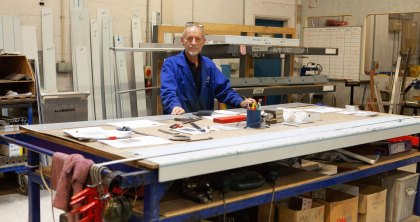Posted on December 19, 2023 in Blog, News, Sustainability, Technical
Rooflights featuring toughened or laminated glass, or both, have different applications in construction projects.
Toughened versus laminated rooflights – what’s the difference?
Rooflights featuring toughened or laminated glass, or both, have different applications in construction projects. Broadly, toughened glass provides superior strength, while laminated glass offers better security as it is designed to remain intact when broken. For rooflights designed to take foot traffic such as walk on rooflights, Glazing Vision’s view is that the outer pane should be toughened, heat soak tested and laminated.
When ‘basic’ float glass is annealed, it produces glass that is free of internal stresses caused by other heat treatments. However, annealed glass breaks easily into large shards. That is considered unsafe for certain uses in buildings, and toughened glass and laminated glass are both ways in which float glass can be treated to improve safety.
What is toughened glass?
For a product that breaks into much smaller pieces or granules, and is therefore suitable for safety applications (including overhead rooflights on pitched or flat roofs), toughened glass must be used.
Annealed glass is heated, then rapidly cooled to make the surface of the glass more resistant to tensile failure. Glass cracks due to failure at the surface. The tempering balances compression at the surface with tension in the centre of the pane, making toughened glass some four or five times stronger than annealed glass, and more resistant to blunt impact.
Toughened glass cannot be cut or worked, so all processing has to be carried out prior to toughening.
As it is resistant to large and variable changes in temperature, toughened glass is suited to spandrel panels where there is a risk of thermal cracking. It also offers good resistance to wind pressure on tall buildings and, in particular, corners.
Something to consider is that the heating and cooling cycle required to produce toughened glass causes optical distortion in the surface. When annealed glass is heated again, it sags slightly between the rollers carrying the glass through the furnace; the subsequent cooling results in ripples, or ‘roller wave distortion’.
Roller wave mainly shows up in the reflections of the glass, and eliminating such distortion entirely is impossible. It can only be reduced, mainly by design and control of the manufacturing process and the way in which the glass is heated and cooled, and moved through that sequence. Thicker panes of glass generally remain flatter, while larger panes typically show up more distortion.
Why does toughened glass benefit from heat soak testing?
Spontaneous fracture is known to occur in toughened glass, due to the stabilising of nickel sulphide (NiS) present in the material. The risk of breakage is relatively low, but unpredictable – it could occur within weeks or years of manufacture, if at all.
Heat soaking filters out about 95% of potential problem units. Toughened glass is heated to 290°C and held at that temperature, accelerating the process of any nickel sulphide inclusions reverting to their ‘beta state’ and causing failure.
Inevitably, heat soaking adds cost but improves product quality and consistency, reducing the use of potentially faulty glass in the manufacture of rooflight products.
The use of heat soak testing is not regulated, but reputable manufacturers are more likely to undertake it than not – especially for large structural rooflights or in walk-on applications. Glazing Vision, for example, heat soak test all of the glass they produce as standard, to make sure customers get a reliable and trustworthy solution for their project.
Heat soak testing is not a guarantee that glass will remain failure-free, so manufacturers will not accept any claims for spontaneous failure, but it does reduce the instances of potentially faulty glass entering the supply chain.
What is laminated glass?
Bonding two panes of glass with an interlayer produces laminated glass, a catch-all term to cover the various combinations of glass and interlayer. Because the interlayer holds the glass even when broken, laminated glass is typically used where security is a priority, as well as in safety applications like overhead and walk-on glazing.
By far the most common interlayer is polyvinyl butyral (PVB). Ethylene-vinyl acetate (EVA) is also popular; other interlayer materials include cast-in resins, polyurethanes and ionoplast materials.
Where transparent plastic materials, like PVB and EVA, are used as the interlayer, the bond is achieved through the application of heat and pressure in a controlled environment; however, plastic interlayers make cutting difficult. Resin is a more versatile adhesive and allows for the production of curved laminates.
Demanding performance specifications are driving the development of interlayer solutions, some of which fail to offer adequate levels of adhesion. Manufacturers of proprietary interlayers, such as ionomer-based ionoplast, claim improved performance for especially demanding applications. PVB, however, remains the popular option.
About Glazing Vision
Architecturally ambitious and impressive glazing installations often have to meet higher standards of safety too, because of where and how they are used. Walk-on rooflights are an excellent example of this. At the same time, they must be capable of meeting the thermal and ventilation requirements of building regulations, and help to combat overheating risk.
With the anticipated introduction of the Future Homes Standard in 2025, achieving performance, safety and architectural impact all at the same time will require the right level of expertise.
Glazing Vision can help projects to exceed the requirements of current building regulations, looking towards the Future Homes Standard. Our expert technical support helps you to meet daylight, ventilation and access requirements. We provide all the details required for correct specification, including U-values and CAD drawings.
For further advice and guidance on how Glazing Vision architectural rooflights can help to future-proof your project, download our ‘Homes of tomorrow today’ white paper or contact us.















